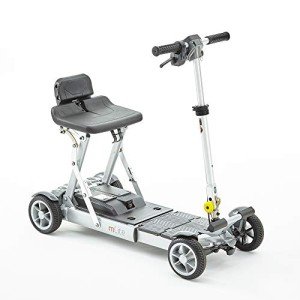A Handbook For Mobility Devices From Beginning To End

Understanding Mobility Devices: Enhancing Independence and Quality of Life
In today's busy world, the desire for mobility is universal. Nevertheless, certain medical conditions or age-related obstacles can prevent movement, causing a continuous search for help. folding mobility scooters with suspension work as important tools to improve independence, improve quality of life, and enable people to engage totally in their communities. This article supplies a detailed overview of mobility devices, including their types, functions, choice requirements, and more.
Kinds Of Mobility Devices
Mobility devices vary from basic aids to complicated equipment, customized to fulfill numerous requirements. Below is a table summarizing common types of mobility devices:
| Type of Device | Description | Suitable For |
|---|---|---|
| Walkers | Four-legged support devices that offer exceptional stability while strolling. | People needing additional assistance. |
| Walking sticks | Single or three-legged sticks that enhance balance and support walking. | Those with small mobility problems. |
| Wheelchairs | Seats mounted on wheels, offered in handbook and electric versions. | Individuals with limited or no mobility. |
| Scooters | Electric vehicles developed for outdoor use and ease of navigation. | Those who can't stroll cross countries. |
| Crutches | Devices that help individuals transfer weight away from an injured leg. | People recuperating from leg injuries. |
| Rollators | Walkers with wheels, seats, and brakes for enhanced mobility. | Users needing rest options while strolling. |
| Lift Chairs | Reclining chairs that help users in standing up and taking a seat. | Seniors or those with mobility restraints. |
| Mobility Scooters | Small electric cars for minimal mobility, often used outdoors. | Individuals needing help over cross countries. |
Key Features of Mobility Devices
When choosing a mobility device, several key functions should be considered to ensure ideal functionality and ease of usage:
- Weight Capacity: Understanding the device's weight limitation is vital for safety and effectiveness.
- Adjustability: Devices needs to be adjustable in height and width to fit the user comfortably.
- Mobility: Lightweight and foldable alternatives are important for users who travel or need transportation.
- Stability and Safety: Look for functions like anti-tip wheels and durable structures to boost security.
- Relieve of Use: Simple systems and easy to use styles can make a considerable distinction in day-to-day usage.
- Comfort: Ergonomic designs and cushioned seats can boost the user experience.
Choosing the Right Mobility Device
Selecting the best mobility device can be a difficult job. Here are some steps to assist the decision-making process:
- Assess Needs: Evaluate the individual's mobility challenges and everyday activities.
- Speak with a Professional: Engage health care professionals who can provide recommendations based upon the individual's physical condition.
- Trial Options: If possible, trial various devices to identify comfort and functionality.
- Review Budget: Consider the cost of the gadget, including any additional features or modifications required.
- Research study Options: Determine the very best brands and designs by checking out reviews and comparisons.
Table: Comparative Analysis of Popular Mobility Devices
| Device | Advantages | Disadvantages |
|---|---|---|
| Walkers | Exceptional stability, promotes walking. | Large, might restrict motion in small spaces. |
| Walking canes | Lightweight, enhances balance. | Might not provide enough support for serious mobility issues. |
| Wheelchairs | Ideal for those with significant mobility limitations. | Can be troublesome, especially in indoor environments. |
| Scooters | Great for outside usage, simple to maneuver. | Restricted indoor use, much heavier. |
| Rollators | Offers rest option, simple to move. | May need more space than standard walkers. |
| Lift Chairs | Comfy, assists shift from sitting to standing. | More expensive, larger footprint. |
Regularly Asked Questions (FAQs)
1. What is a mobility gadget?
A mobility gadget is any tool created to help people in moving and browsing their environment. This consists of walkers, wheelchairs, scooters, and crutches.
2. How do I know which mobility gadget is best for me?
Consider your specific mobility challenges, physical capabilities, and way of life requirements. Consulting with health care experts can also provide tailored suggestions.
3. Are mobility devices covered by insurance coverage?
Many insurance plans, consisting of Medicare, may cover specific mobility devices. It's important to inspect with your insurance coverage provider for specific coverage information.
4. Can I rent a mobility gadget rather of buying one?
Yes, many medical supply shops and drug stores provide leasings for mobility devices. This alternative is helpful for individuals with short-lived mobility problems.
5. How can I maintain my mobility device?
Regular maintenance is vital. It includes cleaning the device, checking for wear and tear, and guaranteeing all parts are operating properly.
The Impact of Mobility Devices on Quality of Life
Mobility devices significantly enhance the quality of life for individuals with minimal mobility. They promote self-reliance, motivate social interaction, and boost access to vital services and recreational activities.
- Increased Independence: Users can browse their areas, go to occasions, and engage in hobbies without relying on others.
- Social Engagement: Mobility devices facilitate involvement in celebrations, consequently combating sensations of isolation.
- Enhanced Safety: Devices provide stability and reduce the risk of falls, promoting user self-confidence.
Mobility devices are more than simply tools for motion; they are gateways to self-reliance and quality living. By understanding the various kinds of mobility aids readily available, their key functions, and considerations for choosing the best gadget, individuals can make educated decisions about their mobility requires. Eventually, the right mobility device can result in a more active, satisfying life. Whether it's a walker, wheelchair, or scooter, the best choice contributes significantly to boosting the mobility and self-reliance of users.

